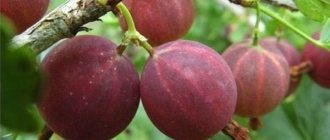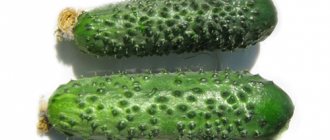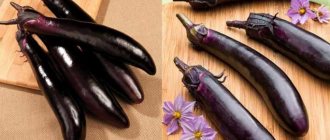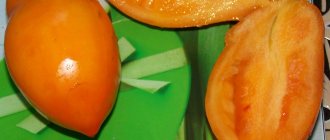Description of the gooseberry variety Chernomor
Gooseberry varieties created at the end of the last century through the efforts of Soviet breeders still enjoy attention from gardeners. The great value of these varieties is determined by their good winter hardiness and resistance to the most formidable crop disease - powdery mildew. Among the time-tested varieties, the dark-colored Chernomor can be distinguished. Its author K.D. Sergeeva, in order to obtain a new product, pollinated seedlings 21 - 52 with a mixture of pollen collected from the already known Date, Green bottle, Brazilian and Mauer seedlings. In 1979, an application for registration of a new product was submitted by the Federal State Budgetary Institution “Federal Scientific Center named after I.V. Michurina." The variety has been under variety testing since 1980. It was included in the State Register of Breeding Achievements of Russia in 1994 and approved for cultivation in the Central region, which includes 8 regions - Ivanovo, Vladimir, Bryansk, Kaluga, Moscow, Tula, Ryazan and Smolensk.
Gooseberry Chernomor belongs to varieties with medium-late ripening of berries. For the rich dark color of the fruit, gooseberries received several more names. Often, among gardeners, it is called “northern grapes” or “garden dates”. This variety of gooseberries was bred by breeders of the All-Russian Research Institute of Horticulture named after I.V. Michurin on the basis of four varieties, including: Date, Seedling Mauer, Brazilian and Green Bottle.
The Chernomor gooseberry bush is slightly spreading, but with a rather thick crown. The branches are straight, light green in color, becoming even lighter over time. They can reach a height of one and a half meters. The shoots are slightly thorny. The spines are single, thin and sparse.
By the way, do you know why the Chernomor gooseberry needs thorns? Thorns are one of the ways to protect a plant, for example, from being eaten by animals, developed over a long process of evolution. Currently, breeders have developed varieties that do not have thorns at all. However, experts note that such gooseberries usually have smaller berries. Therefore, these varieties are not suitable for lovers of large and tasty gooseberries.
The leaves of the gooseberry variety Chernomor are small and bright green. The leaf blade is embossed, the middle of the leaf is convex.
Chernomor gooseberry inflorescences are formed by two or three flowers that have a convex shape. The flowers are painted in a soft green color, have a barely noticeable pink edging, and are small in size. Experts note the great value of the plant as one of the early honey plants.
Gooseberry Chernomor: photo of the variety
The weight of one berry is, on average, 3 grams. The berry harvest from one bush is up to 4 kg. The berries are oval, at the beginning of ripening they are colored dark red, and fully ripened fruits have a rich, seemingly black color. The taste of the fruit is sweet and sour, the tasting score is 4.3 points. The sugar content corresponds to 8.5 - 12%, and acidity to 2.5%. 100 grams of berries contain about 30 mg of ascorbic acid. The skin of the berries is quite dense, so mechanized harvesting of the fruit is possible; they tolerate transportation well and have good shelf life.
Chernomor gooseberries are universal in use. They are great for making jams, marmalade, juices, jellies and, of course, preserves. They are also used to make wine and use them in the preparation of various sauces and jelly.
However, if possible, fully ripened fruits should not be left on the bush for a long time, since they bake in the sun.
The Chernomor gooseberry variety is self-pollinating; however, experienced gardeners who practice growing Chernomor gooseberries still recommend planting other gooseberry varieties next to the shrub that have the same flowering period as the variety in question.
The gooseberry variety Chernomor is characterized by good resistance to drought and tolerates less than regular watering. This feature is due to the fact that the gooseberry root system is quite deep and the shrub makes up for the lack of moisture by drawing liquid from the deep layers of the soil.
In addition, as noted earlier, this variety is frost-resistant and, despite the fact that it is recommended more for the Central part, Chernomor gooseberries are successfully grown in many regions with colder climatic conditions.
Self-fertility
The Chernomor variety is a self-pollinating variety, but to enhance fruiting, pollinators are planted nearby. They should be located at a distance of 3 meters from each other.
Description of the bush and berries
The plant is a vigorous plant, its height reaches 1.5 meters. At the same time, the gooseberry bush is not too spreading, as if compressed, with a thick crown. The number of root shoots is average. The branches of Chernomor are directed vertically upward, the degree of branching is moderate. The growing shoots are medium-sized, straight, sometimes with a hanging tip, the bark is pubescent, light green in color with anthocyanin coloring in the upper part. Lignified shoots are medium-sized, light-colored. Shoots with weak thorniness. The spines are usually single, sparse, short or medium in length, straight or slightly curved, thin, dark-colored, matte, growing downward, localized in the lower part of the shoot. There are no spines. The buds of the variety are small, hairless, oblong in shape with a pointed apex, light-colored, and grow deviating from the shoot. A trace from a fallen leaf is round in shape.
The leaves of Chernomor are small in size, medium density, dark green in color, the surface is convex, pubescent, shiny, smooth or folded. The main veins are not colored. The shape of the gooseberry leaf blade is three- or five-lobed, the cuts between the blades are deep. The central lobe rises above the lateral ones, its apex is pointed, and the lateral edges are cut off towards the base. The length of the lateral lobes is average, they have a rounded shape, the angle of connection between the veins is sharp. The basal lobes are poorly developed, their veins are spread out. The leaf has a straight base, sometimes with a shallow notch. The angle between the petiole and the base of the blade is most often straight. The petiole is of normal length and thickness, the lower part is covered with sparse glandular pubescence, and is located at an angle of 30 °C to the shoot. The inflorescence of the variety consists of 2 - 3 medium-sized flowers. The corolla is elongated, brightly colored. The sepals are free, bent upward, somewhat elongated, brightly colored. The ovary is anthocyanin colored and covered with slight pubescence.
Reviews from summer residents
Gardeners speak positively about Chernomor.
Maria, Tula: “ In my opinion, this is the best variety of gooseberry. It has been growing on the site for many years, it bears fruit consistently, the harvest is large, and the bushes have never gotten sick. Of course, I carry out preventive treatments, but I think it’s not only this, but also the high immunity of the plant.”
Irina, Moscow region: “Gooseberries are my favorite berry. I used to buy it all the time, and when the plot became available, I planted several bushes. On the advice of friends, I chose Chernomor and I don’t regret it. The berries are very tasty, aromatic, they are a pleasure to eat fresh, and the jam turns out excellent. The seedlings took root quickly and began bearing fruit the very next year. The bushes do not get sick and are resistant to cold and drought.”
Valery, Bryansk: “Chernomor is definitely one of my top five favorite gooseberry varieties. Apart from the rather small berries, I don’t see any shortcomings in it. The bushes are compact, and with proper and regular pruning they become a real decoration of the site. They don’t get sick, pests don’t attack them, they bear fruit well, and the yield is high every time.”
Characteristics of the variety
- Chernomor has good precociousness. Already in the second year after planting, a harvest can be expected;
- The State Register defined the ripening period as medium-late. But some gardeners note that in the conditions of the Moscow region, gooseberries ripen at an earlier date;
- The yield of marketable fruits over the years of the study was 7.0 t/ha. According to VNIISPK, this figure is 10.3 t/ha. The minimum indicator is 2.1 kg per bush, the maximum is 4.0 kg;
- self-fertility is low, at the level of 5 - 14% of the total yield. In order for our hero to be able to show the maximum level of yield and berry size, varieties that bloom at the same time should be planted nearby;
- decent immunity. The species has good resistance to powdery mildew. Resists well against pests, such as fireweed;
- durable skin protects gooseberries from cracking and makes mechanized harvesting possible;
- drought resistance is good. The plant can tolerate even a long period of lack of moisture. Chernomor is also valued for its resistance to other adverse climatic conditions;
- the variety has shown high winter hardiness, allowing the plant to withstand the complex effects of the external environment during the winter and early spring periods;
- the transportability of the fruits is good; if the storage standards are observed, the shelf life does not fail;
- The way to use the crop is universal. The pleasant-tasting berries are consumed in their natural form. The fruits are excellent for processing. Due to the high content of pectins, the pulp makes excellent marmalade or jelly. In addition, this variety is considered one of the best for making wine.
Characteristics: table
| Ripening period | Mid-late ripening |
| Fruit | The berries are medium-sized (3 g), round-oval in shape and oval, dark red, black when fully ripe, thin-skinned, with a waxy coating, without pubescence. |
| Taste qualities | The pulp is sweet |
| Productivity | High-yielding (103-148 c/ha) |
| Frost resistance | Highly winter-hardy |
| Pests and diseases | Resistant to powdery mildew and fireweed |
| Latin name | Ribes uva-crispa |
| Note | Universal |
Winter hardiness
The bush is vigorous and is a mid-late variety. An adult plant can reach a height of 1.5, while it has a dense, but not very spreading, crown. The shoots grow straight and only the tops droop slightly. Young branches are green and without pubescence, but with age they become woody and become light. The spines are sparse, growing downwards and one at a time. The structure of the leaf blade is characteristic of gooseberries, with dark green leaves divided into lobes.
It’s not for nothing that Chernomor is called the northern grape, because its berries really look like grapes. And it became “northern” due to its high winter hardiness. The shrub tolerates low temperatures well and is successfully grown throughout almost the entire territory of our homeland, right up to the northern regions. It is also not afraid of drought, and the variety gets sick many times less often than other relatives.
The oval-shaped berries weigh up to 3 g each. At the beginning of ripening they are dark red, but at the stage of full maturity they become black. The berries are covered with a fairly dense skin and have slightly branched veins. The pulp is more sweet than sour, and gooseberries have a strong, pleasant aroma.
Precociousness
The variety is fast-growing and begins to bear fruit early. After planting, a tree of the Chernomor variety bears fruit in 2-3 years.
Ripening period
Flowering occurs in the middle or end of May. The fruits ripen by early July.
Fruiting, productivity
The fruits of the Chernomor gooseberry (shown in the photo) are characterized by:
- harmonious, sweet and sour taste (taster rating – 4.3);
- good yield (up to 10 t/ha or up to 4 kg per bush);
- strong skin (suitable for mechanized harvesting);
- early ripening (first and second decades of July);
- good transportability and keeping quality.
The chemical composition of Chernomor variety berries in terms of sugar content is in the range of 8.4-12.2%, and in terms of acidity ─ 1.7-2.5%. The amount of ascorbic acid per 100 g of gooseberries is 29.3 mg.
Preserves, jams, jellies, juices, marmalades, wine are made from the fruits of this variety, as well as delicious sauces, casseroles, kvass, and jelly. Gooseberries are also suitable for fresh consumption. The shrub is of great value as an early honey plant.
Application area
Juices, jams are made from the fruits of the Chernomor gooseberries, and added to baked goods. You can decorate desserts with berries, or freeze them for the winter.
Transportability
Gooseberry fruits of the Chernomor variety can be transported over long distances, having previously been placed in the required containers. Since the skin is of medium density, the berries do not wrinkle and preserve their presentation.
Disease resistance
The Chernomor variety is considered resistant to powdery mildew. But still, the risk of developing fungal diseases is quite high for this crop. To prevent the development of possible diseases, gooseberry bushes need regular treatment with special protective compounds designed to prevent the spread of infections. As a preventative measure, many resort to a procedure such as pouring boiling water over the planting hole - this allows the soil to be disinfected from most pathogenic microorganisms.
Planting and care
Planting annual Chernomor seedlings is best done in the fall - at the end of September or beginning of October. Gooseberries are a heat-loving and light-loving crop, so the sunniest places should be allocated for planting. Avoid areas where groundwater rises higher than 1.5 meters to the soil surface. In such areas, the root system will suffer, and after it the entire bush. After planting, the plant needs regular watering. An adult bush is moistened moderately, taking into account natural precipitation. Fertilizers combining organic matter and mineral fertilizers are required. Thinning, sanitary and rejuvenating pruning is also important for our hero. The variety can also be grown as a standard form, but in too hot climates, the bush, ordinary variety is still preferable. Gooseberries propagate easily using layering and green cuttings.
Chernomor is quite popular among gardeners who respect the culture for its high productivity, ease of care, good taste and the possibility of universal use. The variety is highly rated, claiming that it can give a head start to many new varieties. The almost complete absence of thorns will protect your hands during harvesting. A high level of winter hardiness and resistance to powdery mildew are the main qualities that experienced gardeners pay attention to. These indicators are quite reliable in the gooseberry cultivation region, as well as drought resistance, which is confirmed by numerous positive reviews. A small minus is that the size of the fruit is not large enough. There is some debate about the taste, while many rate the taste as very good, some still remain dissatisfied with the lack of zest, calling the taste simple.
Reproduction methods
Gooseberry Chernomor is propagated by horizontal layering or cuttings. Inexperienced gardeners are recommended to propagate the crop using the first method.
By layering
The branches are buried in several stages. First, place a healthy shoot of the Chernomor variety in a shallow groove, pin it with a staple, and sprinkle it with soil. Then, water with 0.5 buckets of settled water. In the fall, rooted cuttings are planted in a permanent place in the garden.
Cuttings
When using this technique, the highest survival rate is observed. In one planting you can get a large number of sprouts of the Chernomor variety. They take 2-year-old shoots, cut them into pieces 12-15 cm long, and plant them in a substrate prepared from sand, peat and garden soil. Before planting, treat them with a rhizome growth stimulator.
Advantages and disadvantages of the variety
Chernomor gooseberry is one of the most popular types of crops and has many advantages. Some summer residents found errors in it. Familiarizing yourself with them will help you learn more about the plant and make your choice.
| pros | Minuses |
| High frost resistance | Small fruits of the Chernomor variety |
| Resistance to dry periods | |
| A small number of tweezers | |
| Simple breeding process | |
| Excellent taste of fruits of the Chernomor variety |
Planting gooseberries Chernomor
According to the description, Chernomor gooseberry is not a demanding plant in terms of growing conditions. But to obtain the desired results, you must adhere to a certain growing algorithm.
Deadlines
Gooseberries of the Chernomor variety are optimally planted in autumn or spring. Autumn planting is more preferable, then the seedlings have time to take root before the arrival of cold weather. It is important that there is 1 month left before frost.
Selecting a location
Chernomor gooseberry, like other varieties of this berry crop, prefers to grow in areas with a sufficient level of illumination and protection from draft winds. It is not recommended to choose clearings that are shaded or with close groundwater (from 1.5 meters).
If you plant Chernomor gooseberries in an area with high soil moisture, then there is a high probability of putrefactive processes developing on the root system of the planted gooseberry seedlings. Optimal timing for planting: late September-early October.
Selection of seedlings
Before purchasing planting material, it is necessary to inspect it for signs of disease, signs of damage, and rot. The process of preparing seedlings involves pruning shoots to 5 buds and removing dried roots. It is better to buy two-year-old plants with an open root system, which simplifies the selection of a quality plant.
If Chernomor gooseberries are sold in a pot, then their age can be any. The recommended length of leafy shoots is 40-50 centimeters, the roots are abundant and white. The underground part of the bush should tightly braid the earthen ball. Such specimens can be planted 2-3 weeks after purchase.
Soil composition
You can grow Chernomor gooseberries on almost all types of soil: sand, washed-out clay, sod-podzolic. Good productivity indicators of the variety are observed when cultivated on peat soils. But it is best to set up a plantation on forest-steppe and gray forest-steppe soils, medium and light loams. On them, Chernomor gooseberry bushes grow strong, resistant to adverse environmental factors, and have a long lifespan.
It is also possible to plant Chernomor gooseberries on depleted soils, but you must first add old organic humus from composted manure. Thanks to natural fertilizers, the structure of the soil improves and the degree of fertility increases.
Well preparation
Before planting seedlings, it is necessary to remove all weeds from the site, especially attention should be paid to wheatgrass and thistle. These plants grow quickly, and weeding them out from under the bush in the future will be extremely problematic. Considering the spreading nature of the shrub and its height, the plants should be placed at a distance of 1-1.5 from each other so that they do not experience a lack of nutrition or moisture.
The soil for normal growth and development of Chernomor gooseberries is filled with the following nutritional compounds:
- compost or rotted manure (10 kilograms per garden planting);
- wood ash (100 grams);
- double superphosphate (50 grams);
- potassium sulphide (40 grams).
The dimensions of the planting holes are 30 x 40 x 40 centimeters.
Planting seedlings
It is recommended to treat the selected planting material with a growth stimulator. Its roots are immersed in the working solution for 10-15 minutes. The technology for planting Chernomor gooseberries involves performing the following actions:
- It is better to pour a layer of fertile soil into the hole in the form of a mound.
- Place the prepared seedling in the center of the hole.
- Straighten its roots and gently sprinkle with soil, slightly compacting it.
- Water thoroughly and mulch the soil around the tree trunk with peat and rotted sawdust. Just dry soil will do.
- After 3-4 days, irrigation and mulching are repeated again.
You should not deepen the root collar of the Chernomor gooseberry too much; it is enough to determine it to a depth of 3-5 centimeters.
Growing technology
Chernomor is undemanding to soil composition. For its successful cultivation, the main thing is to choose a suitable place on the site and provide proper care.
Optimal conditions
For planting Chernomor, choose a well-lit area, protected from drafts, located on a plain or hill.
The soil should be light and loose, allowing air and moisture to pass through. The ideal option is forest-steppe soil, medium or light loam. The variety grows well on sandstones, peat bogs and in soddy-podzolic soil.
Reference. The optimal depth of groundwater is no higher than 1.5 m.
It is better to choose a two-year-old seedling, with an open root system, without damage, signs of rotting or disease. The plants in the pot should have a lot of white roots, and the length of the shoots with leaves should be 40–50 cm.
Before planting, the seedlings are pruned: the tips of the roots and all dry or damaged areas are removed, the branches are shortened so that 5-6 buds remain on them. The roots are soaked for at least 3 hours in a solution of a growth stimulator (Kornevina, Epina) and dipped in a mixture of mullein and clay.
Landing dates and rules
Plants are planted on the plot in early spring (before sap flow begins) or in autumn (late September - early October).
Landing rules:
- Dig planting holes 30–40 cm deep.
- Prepare a nutrient mixture (10 kg of compost, 50 g of double superphosphate, 100 g of ash and 40 g of potassium sulfide), pour it onto the bottom of the hole and form a hill.
- Place the seedling on it, carefully spread the roots along the slopes.
- Fill the holes with soil so that the root collar is buried a maximum of 5 cm.
- Water the plantings at the rate of 10–12 liters for each seedling.
- Mulch the ground with peat or sawdust.
The optimal distance between bushes is 1.2–1.5 m, between rows - 2 m.
Further care
Water the gooseberries as needed, based on weather conditions and soil type. Be sure to moisturize during the following periods:
- before flowering begins;
- during the formation of ovaries;
- before fruit ripening;
- after harvest;
- before wintering.
Water is poured strictly at the root. Moisture on the leaves provokes the development of diseases.
After each watering, the soil around the bushes is loosened to improve its aeration, moisture permeability and to avoid the formation of a dry crust on the surface.
They begin to feed the bushes 4 years after planting. Once every 3 years, 150 g of superphosphate, 40 g of potassium sulfate, 200 g of wood ash and 10 kg of organic fertilizers, for example, rotted manure, are added to each plant. Every year, in early May, Chernomor is fertilized with urea (15 g per bush, after the flowering period - 10 g).
In the second year of cultivation, the bushes are pruned, leaving 4 skeletal branches growing opposite each other. Every year, cut off all old, damaged, dry shoots that thicken the crown and grow inward. The procedure is carried out in the spring, before the beginning of the growing season, or in the fall.
Possible problems, diseases, pests
Chernomor has good immunity and is resistant to most diseases characteristic of the culture. Immune to powdery mildew and moths.
To prevent fungal diseases in the spring, gooseberries are treated with Topaz, Tiovit Jet or Karbofos solution.
Among the pests that pose a danger to Chernomor are aphids, sawflies and moths. To protect against insects, plants are sprayed 3-4 times with “Samurai”, “Fufanon” or “Tsiperus” during the growing season.
Wintering
Despite the frost resistance of the variety, it is important to prepare the bushes for winter. To do this, the soil between the rows is weeded, cleared of debris and plant debris and loosened to a depth of 15–18 cm. After this, water-recharging irrigation is carried out (30–40 liters of water per 1 m²) and the tree trunk circle is mulched with a layer of peat or sawdust.
Features of cultivation depending on the region
Chernomor's requirements for planting and care do not depend on the growing region. However, in areas where the climate is hotter and drier, more abundant and frequent watering is carried out, and in regions with frosty winters, bushes are covered with agrospan in late autumn, which is not necessary, for example, in Central Russia.
Caring for Chernomor gooseberries
The gooseberry variety Chernomor does not cause problems during the growing process; caring for it consists of performing basic agrotechnical practices, including organizing an irrigation system, removing weeds, fertilizing, protecting from pests and diseases.
Watering
During the dry season, gooseberry bushes should be moistened regularly, starting the procedure as the top layer of soil dries. It is necessary to pour water at the root, avoiding contact with the leaves of the crop. Otherwise, there is a high probability of developing diseases. The sprinkling method does not work in this case.
Harvest and storage
Chernomor gooseberries for processing are harvested 2 weeks before consumer maturity, when the fruits are still green, hard, and have reached the desired size. To eat them fresh, the berries are picked completely ripe. Then they acquire sweetness, a characteristic dark burgundy hue.
The harvest harvested at the technical ripeness stage is stored for 2 weeks in a cool place like a refrigerator or cellar. Before being sent for storage, the fruits are sorted and damaged and rotten ones are discarded.
Harvested Chernomor gooseberries at the stage of full ripeness are stored in baskets for up to 1 week. Harvest in dry weather.











